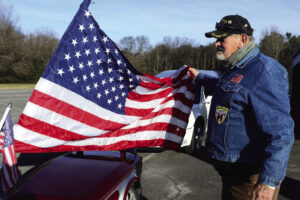Pacific Northwest: Wide range of quality wines
By By Stan Torgerson / wine columnist
Aug. 14, 2002
There are a number of pretenders to California's throne as king of American table wine. New York has tried. Texas likes to think it makes wines that are at the least acceptable. There are wineries in Tennessee, North Carolina even Mississippi.
Probably the one most local wine lovers have visited is the famed Biltmore Estate in Asheville, N.C.
The house is gorgeous, America's largest, 250 rooms on an 8,000-acre estate. It is well worth seeing and touring. Their winery is beautiful, but it has a problem. The wine isn't very good. They offer a tasting bar at which they serve thimble-sized tastes of wines allegedly made from grapes grown on the estate.
Some are, but others are trucked in from California. The labels are attractive and the hype is first-class. People are romanced to buy full bottles of the Biltmore wines and many of them leave thinking they are taking home something special.
Unfortunately they're wrong.
None of the Biltmore wines are crisp, well-balanced or competitive. Most have a touch of sweetness that disguises the true flavors of the grapes from which they were made. Describing them as average would be kind. That is also true of Tennessee, Mississippi and Texas wines. Those from New York are perhaps a small step up, but you can buy better for the same or slightly more money.
Washington and Oregon wines
The only true competitor King California has are the wines of the Pacific Northwest, Washington and Oregon.
There are many wonderful wines made in that area, particularly pinot noir. But respectable chardonnay, syrah and cabernet sauvignon are also produced. The merlot from the Columbia Crest winery is considered one of the finest inexpensive wines of its type made anywhere, including California.
Doubters have a right to ask how can that be?
Those doubters will be surprised to learn that because of its location and lack of cloud cover, the Columbia Valley enjoys an average of two hours more sunlight during the middle of the summer than the Napa Valley. Despite its reputation for rainfall, there are more than 300 cloudless days each year. Annual rainfall in the Columbia Valley averages only about 15 inches. And grapes love sunshine.
Grapes were first planted in what is now the state of Washington about 1825 by traders from the Hudson Bay Company. The first legitimate winery was built in Walla Walla about 1860, but commercial wine production really did not get under way until the 1930s.
The first grape vines in Oregon date back to about 1854, but the industry as such did not move into prominence until the 1970s. Then it developed quickly as winemakers discovered the climate was excellent for pinot noir grapes, the same as are used in the Burgundy region of France.
Pacific Northwest comes into its own
The real turning point came in 1979 when an Oregon winemaker named David Lett who owned the Eyrie Vineyard entered his pinots in a blind tasting sponsored by the great French burgundy firm of Robert Drouhin.
Drouhin's own wine won but, to everyone's surprise, the Oregon entry took second place beating many famous French wines in the process. From that point, Oregon pinot noirs were off and running and some generous critics believe the day will come when those wines will challenge the great wines of Burgundy bottle to bottle.
In fact, Drouhin was so impressed with the area's potential that about 12 years ago he opened a winery in Oregon to make pinots such as he makes in France. The American version wines are supervised by Drouhin's daughter, Veronique, who proved she was a talented winemaker in her own right.
As for recommendations, look for the Elk Cove Vineyards (a personal favorite), the King Estate about which we have written before, Ponzi Vineyards, much more expensive but worth it, Hogue Cellars, Ste Chapelle, Adelsheim and Chateau Ste. Michelle.
The best of the wines from the Pacific Northwest also include those from Columbia Crest which, in addition to fine low-cost merlots, produces greatly admired chardonnay and cabernet sauvignon. They are truly great values.
We have included a few of these wines in past tastings. But the tasting on Aug. 29 will be dedicated to the wines of the Pacific Northwest, both red and white. Most will be dry but we plan to slip in a riesling or two plus the little known semillon white wine, along with a pinot noir, merlot, a cabernet and others.
Reservations are now being accepted. Call 482-0930 to make yours. If you are unfamiliar with the wide range of quality wines from the Pacific Northwest, this will be your opportunity to learn and enjoy some wonderful wines in the process.










